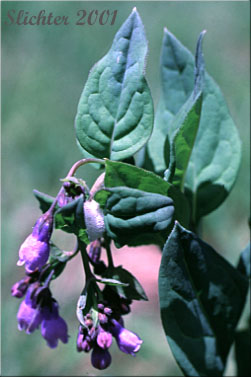 The
photo at right represents tall bluebells from Wild Cheat meadows in the Mt. Jefferson
Wilderness............June 18, 1992.
The
photo at right represents tall bluebells from Wild Cheat meadows in the Mt. Jefferson
Wilderness............June 18, 1992.
Tall bluebells is an attractive wildflower with many erect, leafy stems from 20-150 cm high. The stems and leaves may be smooth (glabrous) or hairy. The leaves are largely on the stems, although the basal leaves when present are long petiolate and heart-shaped. The stem leaves are well-developed with short petioles and a lanceolate to broadly ovate shape, with the tips of the blades tapered to a point and the base rounded. Leaves range from 3-14 cm long and 1.5-7 cm wide and the blades are thin in cross-section and visibly veined.
The inflorescence is branched and open with numerous pendant, bluish-purple flowers. Individual flowers are tubular and 9-16 mm long, with the limb or distal portion of the corolla 1.2-1.6 times as long as the tube. The clayx ranges from 2-6 mm long, the 5 lobes cleft to below the middle or to the base. The calyx margins are hairless.
Tall bluebells may be found in riparian areas on stream banks, in wet meadows, damp thickets, wet cliffs and talus slopes from the foothills to high elevations in the mountains.
Tall bluebells may be found from Alaska south to southwestern and central Oregon and east to Quebec, Ontario, Iowa, Montana Mineral County, and Idaho (Elmore and Adams Counties). It is found east of the Cascade Mts. except in the Olympic Mts.
In the Columbia River Gorge, it may be found at an elevation of 4000' on talus slopes above North Lake.